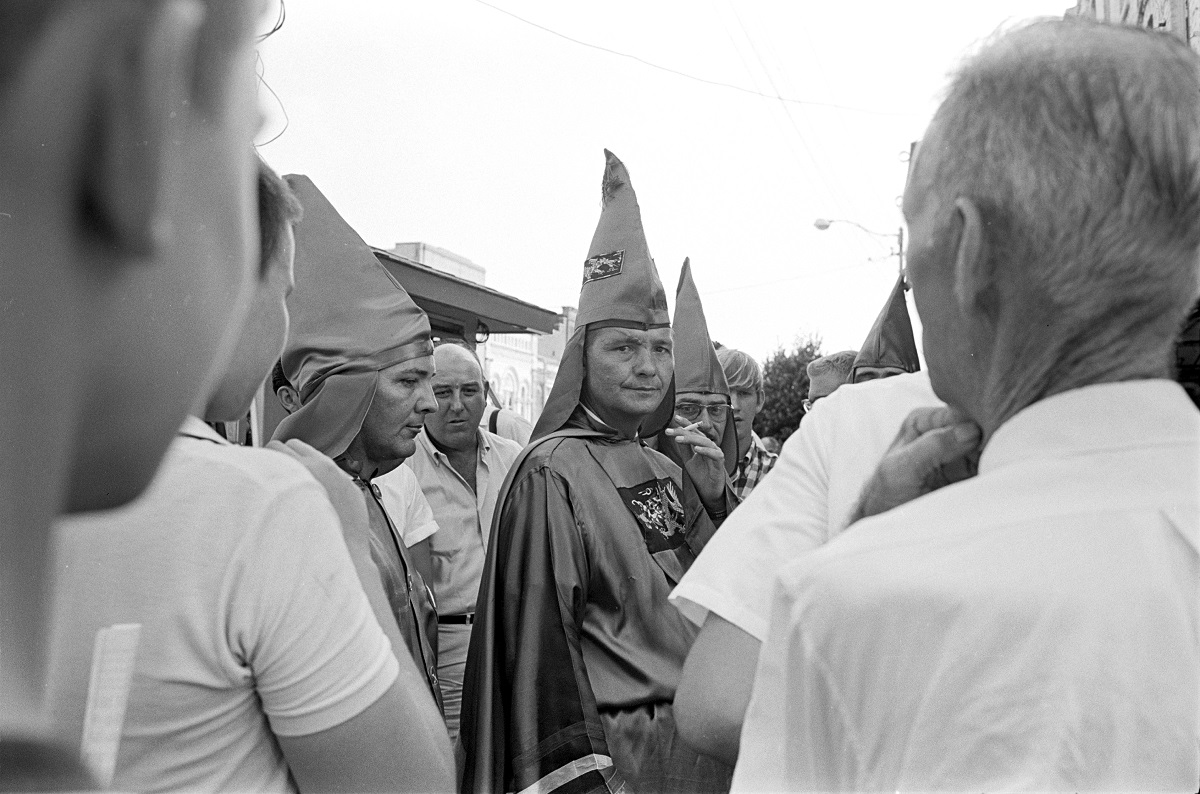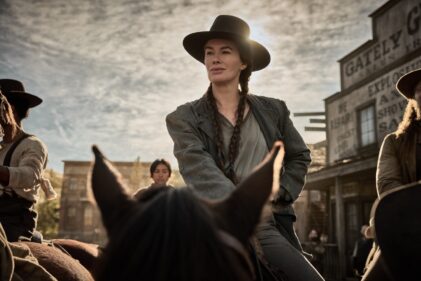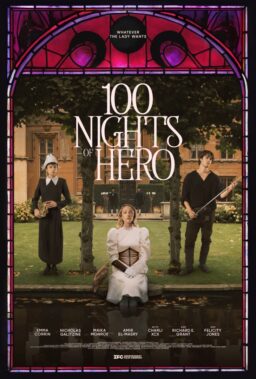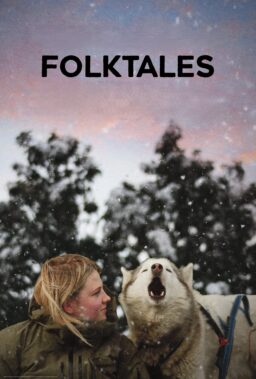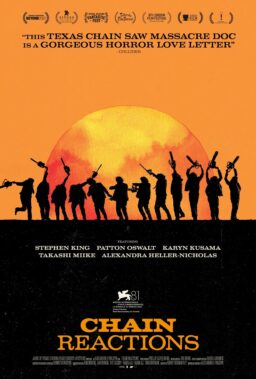Growing up in Raleigh during the Civil Rights era, I had a
friend whose father was a judge known for his waspish, sometimes surreal sense
of humor. One day in court he did something that evidently angered the Ku Klux
Klan, because when he got home there was a large cross burning in his front
yard. Without hesitation, he yelled inside the house, “Kids, get the hot dogs!”
So my pal and his siblings had a weenie roast over the burning cross—a
rebuttal to the KKK that caused great hilarity across the state capital.
That provocation on the judge’s part was perhaps not as
risky as it may sound. He had the advantages, after all, of being a white, socially
prominent city dweller. But there was also the fact that, unlike its
counterparts further to the south, the North Carolina Klan of that era
proclaimed itself to be nonviolent, a distinction that’s central to the
fascinating story told in Callie T. Wiser’s illuminating, expertly crafted
documentary “Klansville, U.S.A.” (airing as part of the American Experience
series on PBS on Jan. 13).

Wiser’s film shows that there was considerable complexity to
the Klan during its three major phases, and even within each phase. Founded in
Tennessee just after the Civil War, almost as a gentlemen’s club for
ex-Confederate officers bent on reclaiming some of their lost prerogatives, the
first Ku Klux Klan (the name derived from the Greek word for circle) used
outlandish costumes to frighten former slaves trying to assert their rights.
But the pranks soon turned into brutal terrorism and lynchings, with the result
that federal authorities forcefully intervened and drove the group out of
existence by 1871.
In a bitter irony, the Klan’s second incarnation was owed to
the advent of the movies. Released in 1915, D.W. Griffith’s brilliantly
crafted, three-hour “The Birth of a Nation” became American cinema’s first
blockbuster with a story that showed the Klan saving the South from ruin after
the Civil War. Hugely successful with white Americans of every class and
region, the film inspired a new, nationwide Klan in the 1920s that, at its peak, had four million members and major chapters in places like Denver, Detroit and
Portland. Less anti-black than Protestant nativist, with an animus against
Catholic immigrants flooding into the country from southern Europe, this Klan
elected ten governors but, due to press exposés and internal divisions, was
effectively out of business by the 1930s.
The third Klan was, of course, a product of the Civil Rights
era, having a career that lasted roughly 15 years, beginning with the storm of
Southern anger unleashed by the Supreme Court’s blow against segregated
education in Brown v. Board of Education in 1954. In North Carolina, the
transition out of Jim Crow was accomplished fairly smoothly, thanks in large
part to the state’s progressive political culture. So how did North Carolina
end up with a Klan membership that dwarfed those of other states?
As “Klansville, U.S.A.” (also the title of a book by
historian David Cunningham on which the film is partly based) tells it, the
Klan’s success in North Carolina was partly owed to the fact that its political
culture was so moderate. (Wiser
amusingly and accurately suggests that N.C.’s self-image owed lots to the
idealized version on “The Andy Griffith Show.”) States further south had racist
demagogues like George Wallace in Alabama and Lester Maddox in Georgia, who
voiced the rage of many whites in shaking their fists at “intrusive” federal
civil rights efforts. Led by modernizing governors like Luther Hodges, Terry
Sanford and Dan Moore, North Carolina had no prominent public mouthpiece for
white anger and resentment…until the new Klan gave it one.
The visionary behind the Tar Heel state’s KKK revival was an
ordinary-looking native of Salisbury, N.C., named Bob Jones, who claimed his
mother marched in a 1920s Klan rally when she was seven months pregnant with
him. After the civil rights movement kicked off with lunch-counter sit-ins in
Greensboro in 1960, Jones sensed a rising tide of inchoate white antipathy. In
August of 1963, he petitioned the United Klans of America to start a chapter in
North Carolina, and he became its Grand Dragon. That same month, just three
days after Martin Luther King Jr’s March on Washington, he advertised a Klan
rally hoping to draw a few hundred sympathizers; two thousand people showed up.
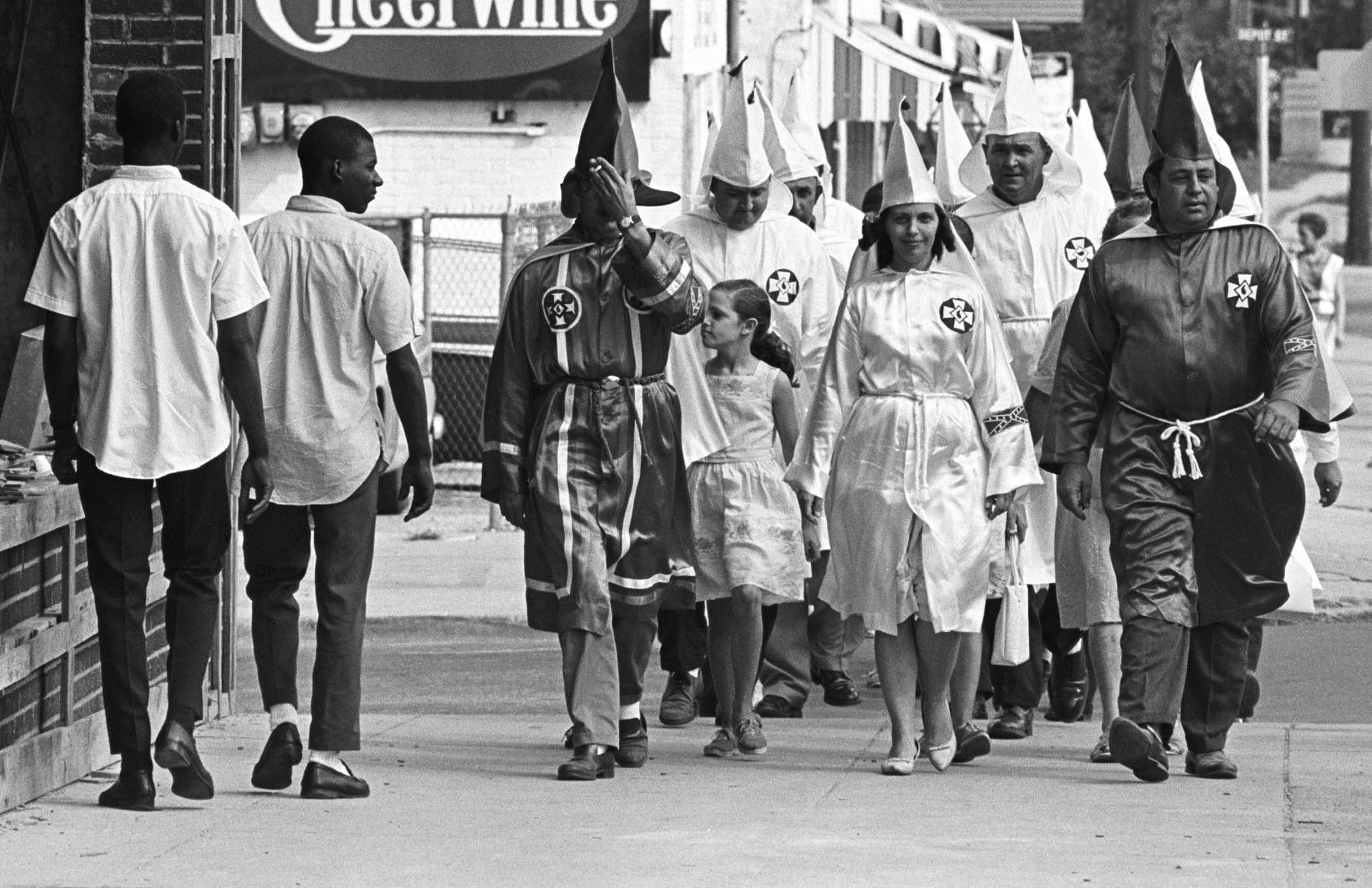
No doubt many educated, urban, middle-class North Carolina
whites disliked the civil rights movement and the new laws it was about to
produce. But these folks weren’t Jones’ constituency. He looked primarily to
lower-class whites, mostly in small towns and rural areas, who thought that any
rights, privileges and advancements won by others were being taken from someone: namely, them. Though his rhetoric was blatantly
racist, Jones claimed he didn’t hate blacks or Jews. He told his followers: Those people all have groups
representing them and helping them get ahead. “White gentile Protestants” are
the only population without such a group. That’s what the Klan is for.
Though Jones had no degree in marketing, he seems to have
had natural flair for it. Klan rallies in rural areas became popular because
they were as much social as political. There were speeches, sure, but the
family-friendly events also featured music, entertainment, invocations of God
and Jesus, food and drink, even pony rides for the kids. They offered, in
short, a whole evening’s worth of wholesome, patriotic diversion, capped by the
burning of a giant cross.
Of course everyone understood the latter as a naked symbol
of racial intimidation drawn from the Klan’s dark past. But Jones was careful
to keep on the right side of the law. That’s where his avowed policy of
nonviolence came in. He wanted the KKK to be a legitimate political force that
could sway elections, as the 1920s Klan had. His Klan didn’t wear masks and
appear only at night. They wore their robes, faces showing and like-costumed
wives and kids in tow, as they staged daytime marches in Raleigh and other
cities. And this old-wine-in-new-bottles strategy was a howling success. Within
a couple of years, the N.C. Klan’s enrollment peaked at ten thousand due-paying
members, and Jones, who paid himself from those dues, was driving a Cadillac.
A downturn in the Klan’s fortunes began when Jones
symbolically crossed the line he’d drawn separating the N.C. group from
violence and illegality. In 1965, driving back from Martin Luther King’s march
from Selma to Birmingham (dramatized in the film “Selma”), a white civil rights
worker named Viola Liuzzo was shot dead. When three Alabama Klansmen were
charged with the murder, Jones invited them to be honored at a North Carolina
Klan rally. Since President Johnson himself had gone on television to denounce
the Liuzzo murder, it was perhaps no coincidence that the FBI soon took an
interest in the N.C. Klan. Though J. Edgar Hoover had previously been
interested only in monitoring civil rights activists and others suspected of
communist affiliation, with Johnson on his back he quickly turned his attention
to white-supremacist radicals. It wasn’t long before the N.C. Klan was laced
with FBI informants including, as it turned out, Jones’ second in command, a
flamboyant Baptist preacher named George Dorsett.
In another fitting irony, Jones’ own downfall came after he
was called to testify before the House Committee on Un-American Activities and
took the Fifth Amendment scores of times, shocking followers who thought only
leftist radicals used that evasion. As Jones’ treasurer, who resigned on the
spot, said, “Only a communist takes the Fifth Amendment, or someone with
something to hide.”
By 1969, the new N.C. Klan was effectively kaput. But by
then, the need for it had arguably evaporated. In the epochal election of 1968,
former Dixiecrat presidential candidate Strom Thurmond rebuffed the candidacy
of arch-segregationist George Wallace and threw his support behind Richard
Nixon, marking the moment when the white South—of all classes, localities and
education levels—became solidly Republican. With that kind of block, and a
rhetoric of “law and order” having replaced that of race, who needed the old
hoods, robes and burning crosses? Not North Carolina.

